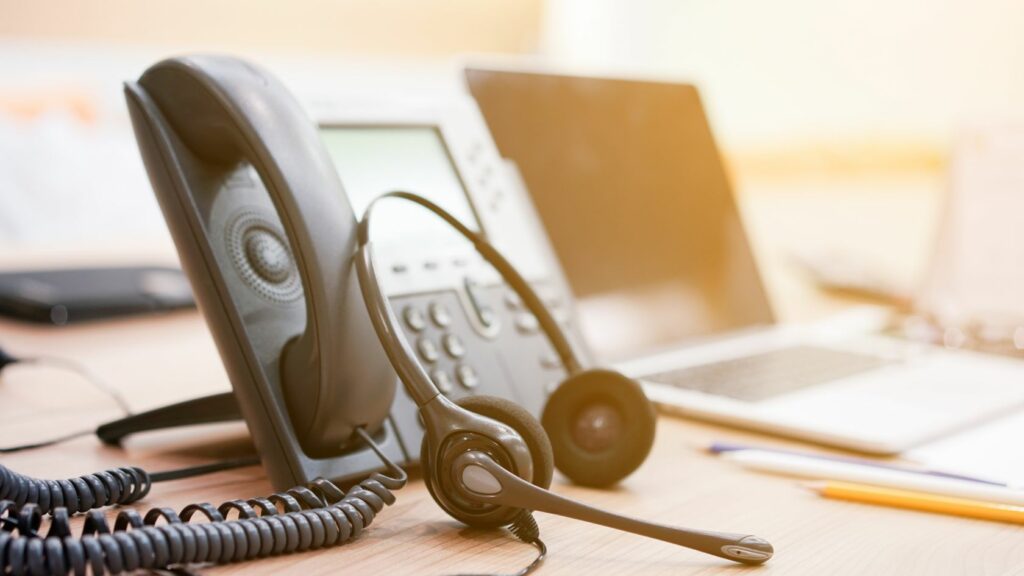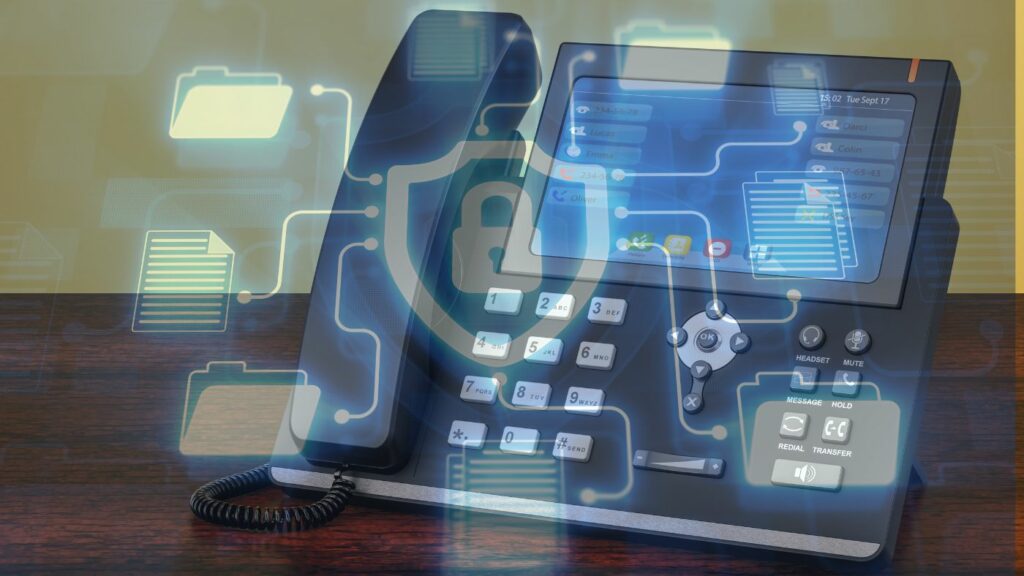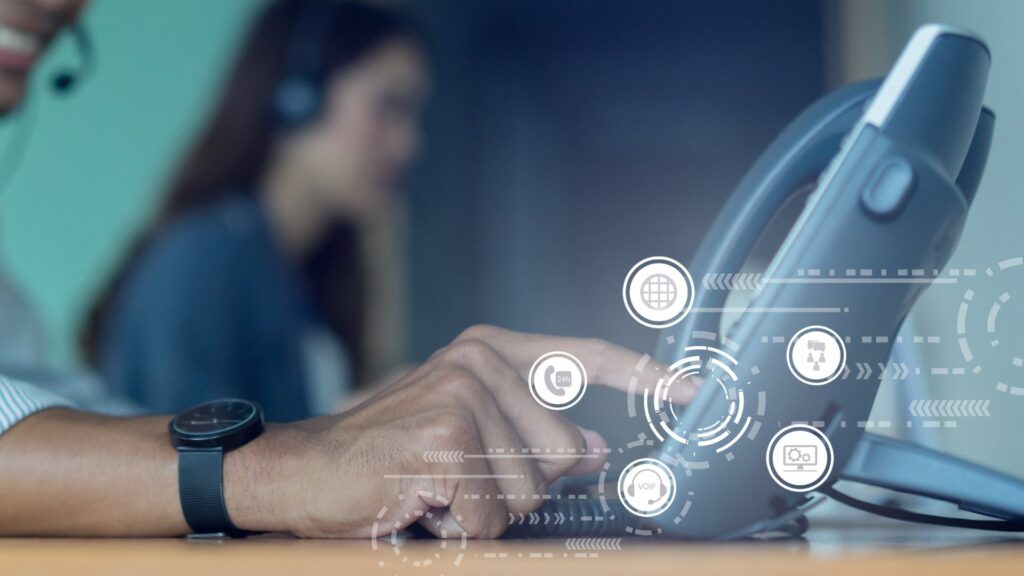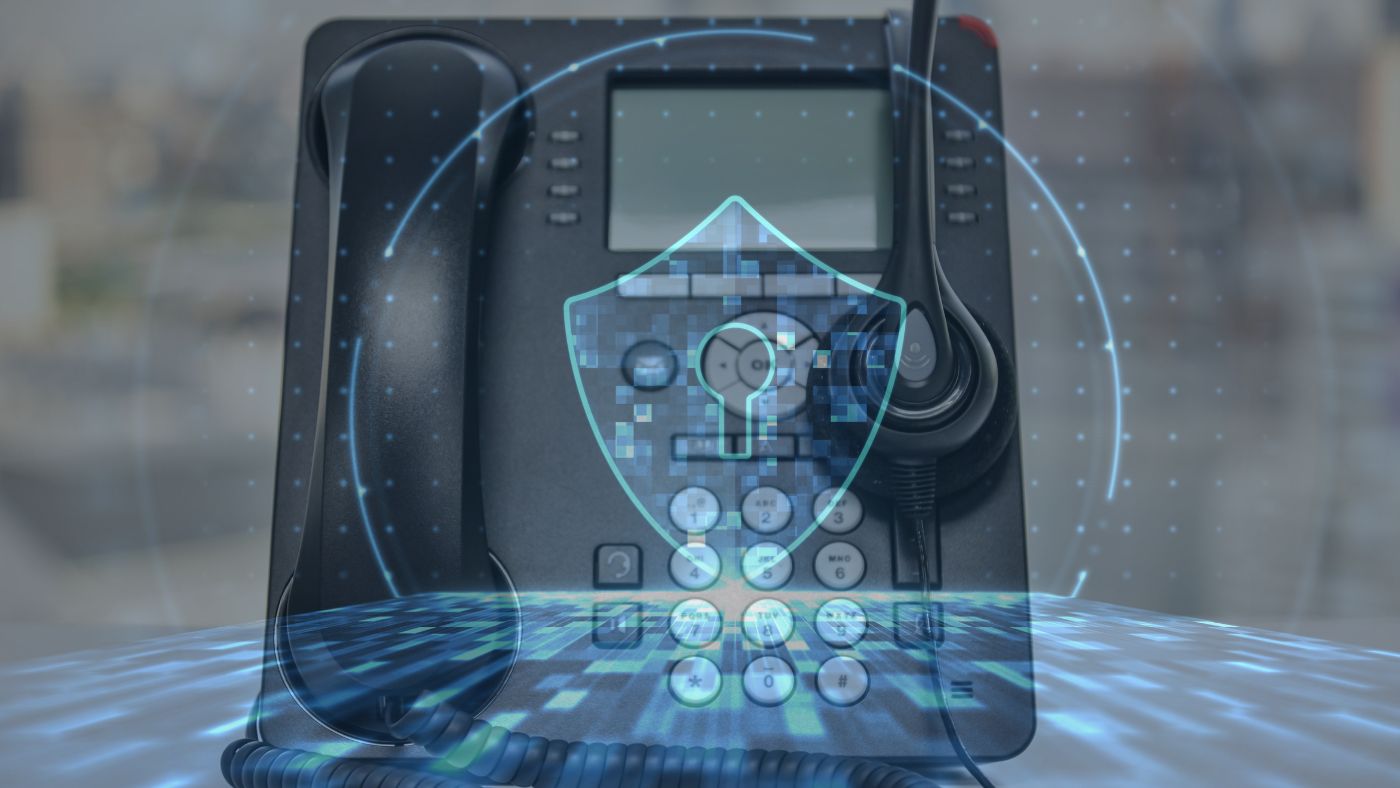In the digital age, the switch from traditional phone lines to VoIP (Voice over Internet Protocol) is like trading a horse and buggy for a sleek electric car. But with every technological leap, new vulnerabilities emerge. VoIP security has become a pressing concern, as it is integral to safeguarding the lifeblood of any modern organisation—its communications. Encryption, firewalls, and session border controllers are no longer spy-thriller jargon; they’re essentials in the VoIP security arsenal to protect against a spectrum of cyber threats.
Threat actors don’t discriminate; from eavesdropping to sophisticated denial of service attacks, the risks to VoIP systems are as varied as they are damaging. Caller ID spoofing and toll fraud can tarnish a company’s reputation, while VoIP spam clogs communication channels, affecting productivity and customer trust. Consequently, understanding and implementing robust security measures is not just an IT issue; it’s imperative for business.
This article is a comprehensive guide as we navigate the complexities of securing VoIP systems. From exploring the importance of protecting sensitive information to adhering to stringent regulatory compliances like the FCC and GDPR, we will examine the strategies that fortify VoIP communication. Uncover best practices, learn from real-life security breaches, and get equipped to lock down your VoIP systems against the ever-evolving cyber threats.
Why is VoIP Security Important?

Voice over Internet Protocol (VoIP) has revolutionised how businesses and individuals communicate. VoIP technology enables voice communication to be transmitted over the internet, often resulting in cost savings and increased flexibility. However, this convenience does not come without risk. As with any internet-based technology, VoIP is susceptible to cyber threats, making security a significant concern. Implementing robust VoIP security measures is crucial to protect sensitive information, shield the system from unauthorised users, and maintain the reliability of communication services.
Protecting Confidential Information
In the digital age, information is often considered the most valuable currency. VoIP calls transmit sensitive data, including personal details, corporate secrets, and financial information, which eavesdroppers or malicious actors can intercept. Ensuring that VoIP communications are encrypted and secure is essential to protect this confidential information from being compromised. The repercussions of data breaches can extend beyond financial losses, leading to reputational damage and loss of trust among clients and partners.
Preventing Unauthorised Access
VoIP systems are not immune to the threats experienced by other components of an organisation’s IT infrastructure. Unauthorised access can result in various security incidents, such as toll fraud, identity theft, or call hijacking. Securing a VoIP system entails implementing strong authentication mechanisms, continuously monitoring suspicious activities, and promptly updating security protocols. Businesses must be proactive in safeguarding their communication networks to prevent intrusions that could disrupt operations or lead to sensitive information being exploited.
Common Threats to VoIP Security

VoIP security is susceptible to various threats compromising privacy, data integrity, and service availability. As VoIP services replicate many features of traditional telephony, they also inherit similar vulnerabilities and are exposed to internet-specific threats. Some of the most common VoIP-related security issues include eavesdropping, caller ID spoofing, denial of service attacks, toll fraud, and VoIP spam. Each threat can potentially disrupt operations and cause significant harm to a business or individual users. Addressing these threats necessitates a comprehensive understanding and a strategic approach to mitigate them effectively.
Eavesdropping and Wiretapping
Eavesdropping and wiretapping are prevalent threats in VoIP communications, where malicious actors listen in on private conversations or data transmissions. This unauthorised surveillance can reveal sensitive information, trade secrets, or confidential data. Encryption protocols, like Transport Layer Security (TLS) and Secure Real-Time Transport Protocol (SRTP), are crucial in deterring such attacks. They ensure that even if the data packets are intercepted, they cannot be deciphered by unauthorised entities.
Caller ID Spoofing
Caller ID Spoofing is a deceptive practice where attackers alter the caller ID to masquerade as another user or organisation. This technique is often employed in phishing schemes and scams to gain the recipient’s trust. To counteract caller ID spoofing, entities can utilise authentication solutions like STIR (Secure Telephony Identity Revisited) and SHAKEN (Secure Handling of Asserted information using toKENs) protocols that aim to validate and certify the identity of callers, creating a more trustworthy VoIP environment.
Denial of Service Attacks
Denial of Service (DoS) and Distributed Denial of Service (DDoS) attacks can overwhelm a VoIP system with excessive traffic, making it unresponsive. These attacks can result in significant downtime and hinder communication capabilities. Protection against such attacks includes implementing firewalls, intrusion prevention systems, and proper network configuration to manage and filter the traffic flow effectively, ensuring that critical VoIP services remain operational.
Toll Fraud
Toll fraud involves the unauthorized use of a VoIP system to make long-distance or international calls, often at the expense of the service owner. This can lead to excessive charges and often go undetected until too late. To combat toll fraud, monitoring tools and setting call restrictions can flag unusual activities. Strong authentication and access control measures can also prevent unauthorized access to VoIP accounts. For a comprehensive understanding, Mobile VoIP explained scenarios highlight the vulnerabilities specific to mobile VoIP services, which can also be susceptible to toll fraud if not properly secured.
VoIP Spam
VoIP spam, also known as SPIT (Spam over Internet Telephony), includes unwanted, automatically dialled, pre-recorded phone calls. This can be more than just a nuisance, as it can tie up lines, reduce productivity, and potentially be used to spread malicious content. Employing anti-spam solutions such as blacklists, CAPTCHAs, and anomaly detection systems can help filter out these unwanted calls and maintain the integrity of VoIP communications.
Security Measures for VoIP Systems

Ensuring the security of VoIP systems is paramount to maintaining confidentiality, integrity, and availability of voice communications. As VoIP technology operates over the Internet, it is imperative to implement robust security measures that protect against a wide range of threats. These measures include deploying encryption protocols, enforcing access control, setting up firewalls and intrusion detection systems, utilising session border controllers (SBCs), and regularly updating software. Leveraging such security mechanisms creates multiple layers of defence, making it more difficult for attackers to compromise VoIP infrastructure.
Encryption
Encryption is one of the most effective tools in securing VoIP communications. It involves converting voice data into a scrambled form that can only be deciphered by an authorised party. Two common encryption protocols include Transport Layer Security (TLS) and Secure Real-Time Transport Protocol (SRTP). When correctly implemented, they help prevent eavesdropping and wiretapping by making intercepted data unintelligible to unauthorised individuals. Employing these protocols ensures that voice data retains confidentiality as it traverses potentially insecure networks.
Access Control
Access control ensures that only authorised users can access VoIP services. This includes implementing strong user authentication methods and managing user permissions. Multi-factor authentication (MFA), complex passwords, and digital certificates contribute to a robust access control system. Furthermore, maintaining an updated directory of users and defining roles ensures that individuals can only interact with the VoIP system within their designated permissions, significantly reducing the risk of internal abuse or external breaches.
Firewalls and Intrusion Detection Systems
Firewalls and Intrusion Detection Systems (IDS) act as gatekeepers for VoIP infrastructures. Firewalls control incoming and outgoing network traffic based on predefined security rules, whereas IDS monitor traffic to identify and potentially stop malicious activities. Together, they provide a comprehensive barrier against unauthorised access and various cyber-attacks. Using application-layer firewalls is particularly effective for VoIP services, as they can inspect and filter voice traffic specifically.
Session Border Controllers
Session Border Controllers (SBCs) manage the voice traffic flow between different networks and secure VoIP infrastructures from attacks. They facilitate safe and seamless communication by performing session control, signal manipulation, and media services for voice and multimedia calls. SBCs also employ security features like topology hiding, which protects internal network structures from external parties. With the ability to monitor and control signalling and media, SBCs are essential in maintaining the security and integrity of VoIP communication paths. Additionally, integrating SIP Trunking with SBCs can further enhance the efficiency and security of business communications, allowing for optimized voice traffic management and robust protection against potential threats.
Regular Software Updates
Staying current with software updates is a fundamental aspect of VoIP security maintenance. Updates often include patches for newly discovered vulnerabilities that attackers could exploit. Regularly updating VoIP applications, operating systems, and related software minimises the potential for exploitation. Having a policy for consistent and timely updates alongside the use of management platforms can streamline this process, ensuring that VoIP systems remain fortified against emerging security threats.
Best Practices for VoIP Security

To maintain robust security for Voice over Internet Protocol (VoIP) systems, adherence to best practices plays a crucial role alongside the implementation of technological defences. These practices encompass everything from the strength of passwords and authentication methods to the education of staff and the preparation for potential system failures. The goal is to create a comprehensive and vigilant environment that consistently upholds the highest security standard for VoIP communications.
Strong Passwords
The foundation of solid VoIP system security is the enforcement of strong passwords. Passwords act as the first line of defence against unauthorised access. Here are a few guidelines to ensure maximum strength:
- Length: Aim for a minimum of 12 characters.
- Complexity: Include uppercase letters, lowercase letters, numbers, and symbols.
- Unpredictability: Avoid using common words and phrases; opt for nonsensical combinations.
- Uniqueness: Use different passwords for different accounts and systems.
A table of password best practices could help users understand the do’s and don’ts:
| Do’s | Don’ts |
|---|---|
| Combine letters, numbers, and symbols | Use easily guessed info (e.g., “password123”) |
| Use non-dictionary words | Repeat the same password across different systems |
| Change passwords regularly | Share passwords through insecure channels |
Enforcing enhanced password policies and encouraging password management tools can significantly bolster the security of your VoIP system.
Two-Factor Authentication
While strong passwords are essential, coupling them with two-factor authentication (2FA) adds a layer of security. Two-factor authentication requires users to provide two different authentication factors to verify themselves. This could be something they know (a password), something they have (a security token or a mobile app), or something they are (biometric verification).
Implementing 2FA can drastically reduce the chances of account compromise, even if a password is stolen. By necessitating a secondary form of proof, authentication becomes a robust, two-step process.
Regular Security Audits
Regular security audits are key to identifying and mitigating vulnerabilities within a VoIP system. Audits should:
- Be scheduled regularly, such as quarterly or bi-annually.
- Include penetration testing to simulate cyber attacks.
- Review access control lists and user permissions.
- Assess the effectiveness of current security measures.
- Result in a detailed report with actionable recommendations.
Periodic audits enable organisations to stay one step ahead of potential threats by proactively uncovering and addressing weaknesses.
Employee Training
Investing in employee training is critical since employees can often be the weakest link in the security chain. Training should:
- Educate employees about cyber threats like phishing and social engineering.
- Demonstrate proper security practices.
- Include guidelines for the secure use of VoIP systems.
- Be an ongoing process, with regular updates as threats evolve.
Informed employees are better equipped to recognise and prevent potential security breaches, thus fortifying the organisation’s overall defence.
Backup and Disaster Recovery Plans
A comprehensive backup and disaster recovery plan is essential to ensure VoIP system resiliency in the face of adverse events. Key components include:
- Regular backups of VoIP system configurations and data.
- Storage of backups in secure, offsite locations.
- Establishment of clear recovery procedures.
- Testing of backup and recovery processes to ensure they work effectively.
Having a well-drafted plan enables swift service restoration, minimising downtime and mitigating data loss in a disaster or cyberattack.
Regulatory Compliance for VoIP Security
While implementing best practices for VoIP security is vital, it is equally important to comply with various regulatory requirements. These regulations are set by governmental bodies and international organisations to ensure that VoIP service providers and users adhere to stringent security and privacy standards. Non-compliance can lead to severe penalties, including fines and, in some cases, legal action. Therefore, understanding and conforming to these regulations is about maintaining privacy and security and fulfilling legal obligations.
FCC Regulations
The Federal Communications Commission (FCC) in the United States establishes regulations that impact VoIP providers. The FCC’s main concern is ensuring VoIP services comply with law enforcement requirements and customer privacy protocols.
| Key Aspects of FCC Regulations |
|---|
| Protect Customer Proprietary Network Information (CPNI) |
| Enable Law Enforcement to conduct lawful surveillance (CALEA) |
| Provide reliable 911 services and accurate location information |
| Ensure accessibility for people with disabilities |
VoIP providers must ensure that they have protections in place for CPNI and comply with the Communications Assistance for Law Enforcement Act (CALEA), which mandates that telecommunications carriers can enable law enforcement agencies to intercept communications. Additionally, VoIP services that replace traditional phone systems must comply with Enhanced 911 (E911) rules, providing emergency services with location information. Providers must also make their services accessible to individuals with disabilities, in line with the FCC’s guidelines.
HIPAA Compliance
The Health Insurance Portability and Accountability Act (HIPAA) sets standards to safeguard sensitive patient data. Any VoIP platform healthcare providers utilise must ensure the confidentiality, integrity, and availability of protected health information (PHI).
| Guidelines for HIPAA Compliance |
|---|
| Implement Technical Safeguards |
| Conduct Risk Assessments |
| Enter into Business Associate Agreements (BAA) |
| Provide Training on PHI Security |
Healthcare organisations must use VoIP solutions with encryption, access controls, and audit controls to track PHI access. Regular risk assessments are instrumental in revealing and mitigating potential security risks. Additionally, if a VoIP service is being used by a third party or business associate, a formal BAA must be executed to ensure the third party’s compliance with HIPAA regulations. Continuous training on the importance of PHI security for all employees is also a critical requirement under HIPAA.
GDPR Compliance
The General Data Protection Regulation (GDPR) is a sweeping privacy and security law enacted by the European Union (EU). Under GDPR, VoIP providers, as well as any organisation handling EU citisens data, must ensure that personal data is processed securely and lawfully.
| Principles of GDPR for VoIP Security |
|---|
| Lawfulness, fairness, and transparency in data processing |
| Limitation of purpose, data minimisation, and accuracy |
| Storage limitation and integrity |
| Accountability |
VoIP service providers must obtain explicit consent to process personal data and are accountable for any data breaches, which must be reported within 72 hours. Data subjects have the right to understand how their data is being used, the right to access it, and the right to request deletion. Compliance with GDPR thus requires VoIP systems to have robust encryption, clear data policies, and procedures to handle user data rights requests. Non-EU companies handling EU citisens data are also subject to GDPR and must appoint a representative within the EU.
Frequently Asked Questions
Why is VoIP Security Important?
VoIP (Voice over Internet Protocol) has revolutionised how businesses and individuals communicate, offering cost savings and increased flexibility. However, like any internet-based technology, VoIP is susceptible to cyber threats. Implementing robust VoIP security measures is essential to protect sensitive information, shield the system from unauthorised users, and maintain reliable communication services.
What are the risks of inadequate VoIP security?
Inadequate VoIP security exposes your system to various threats, including eavesdropping, caller ID spoofing, denial of service attacks, toll fraud, and VoIP spam. These threats can lead to data breaches, financial losses, reputational damage, and disrupted communication services.
How can encryption help secure VoIP communications?
Encryption converts voice data into a scrambled form that unauthorised parties cannot decipher. Transport Layer Security (TLS) and Secure Real-Time Transport Protocol (SRTP) are commonly used to encrypt VoIP communications, preventing eavesdropping and wiretapping.
What is caller ID spoofing, and how can it be prevented?
Caller ID spoofing is when attackers alter the caller ID to appear as another user or organisation, often used in phishing schemes. To validate and certify caller identities, preventing caller ID spoofing involves using authentication solutions like STIR (Secure Telephony Identity Revisited) and SHAKEN (Secure Handling of Asserted information using toKENs) protocols.
What measures can be taken to prevent denial of service (DoS) attacks on VoIP systems?
To prevent DoS attacks, implement firewalls and intrusion prevention systems and ensure proper network configuration to manage and filter traffic effectively. This helps maintain the availability and reliability of VoIP services during attacks.
How can toll fraud be detected and prevented?
Toll fraud involves unauthorised use of a VoIP system to make long-distance or international calls. To detect and prevent toll fraud, use monitoring tools to flag unusual activities, set call restrictions, and implement strong authentication and access control measures to prevent unauthorised access to VoIP accounts.
What is VoIP spam, and how can it be managed?
VoIP spam, or SPIT (Spam over Internet Telephony), includes unwanted, automatically dialled, pre-recorded phone calls. Managing VoIP spam involves using anti-spam solutions such as blacklists, CAPTCHAs, and anomaly detection systems to filter out unwanted calls and maintain the integrity of VoIP communications.
How important are regular software updates for VoIP security?
Regular software updates are crucial for maintaining VoIP security, as they often include patches for newly discovered vulnerabilities. Regularly updating VoIP applications, operating systems, and related software minimises the risk of exploitation by attackers.
What are the benefits of using Session Border Controllers (SBCs) in VoIP systems?
Session Border Controllers (SBCs) manage voice traffic flow between different networks and secure VoIP infrastructures from attacks. SBCs perform session control, signal manipulation, and media services for voice and multimedia calls, providing security features like topology hiding to protect internal network structures from external parties.
Why is employee training important for VoIP security?
Employees can often be the weakest link in the security chain. Regular training on cyber threats, proper security practices, and secure VoIP system usage is essential. Educated employees are better equipped to recognise and prevent potential security breaches, strengthening the organisation’s overall defence.
What are the regulatory requirements for VoIP security?
Regulatory requirements for VoIP security vary by region and industry. Key regulations include FCC regulations in the United States, HIPAA for healthcare-related VoIP services, and GDPR for data protection in the European Union. Compliance with these regulations ensures legal obligations are met and helps protect privacy and security.
Final Words
In the digital age, securing your VoIP systems is no longer optional—it’s a necessity. As businesses increasingly rely on VoIP technology for communication, understanding and implementing robust security measures is essential to protect sensitive information, prevent unauthorised access, and ensure reliable service availability. By employing encryption, firewalls, session border controllers, and regular software updates, you can fortify your VoIP infrastructure against a wide array of cyber threats.
We hope this guide has provided valuable insights into the importance of VoIP security and practical strategies to safeguard your communication systems. Now, we want to hear from you! Share your experiences, challenges, and tips in the comments below. How have you secured your VoIP systems? What lessons have you learned along the way? Your contributions can help others in our community enhance their VoIP security practices and ensure a safer, more reliable communication environment.


